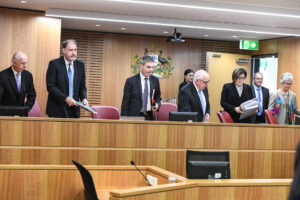Josh Frydenberg is playing us all for mugs – and I’m not talking about those ridiculous “Back in the Black” coffee cups he had made in 2019.
With his third Federal Budget, Frydenberg has delivered on Matthias Corman’s strategy, which he revealed when he let the mask slip in an interview with Sky News on March 8th, 2019 amidst the election campaign.
“Low wages is a deliberate design feature of our economic architecture,” the then finance minister revealed.
True to their word, the Liberal Government has presided over the longest streak of low wages growth in living memory, with a projected figure of just 1.25% expected in the upcoming financial year.
Hey, hang on. Isn’t “Team Australia bouncing back?” And how can an economy that depends on 60% of its horsepower being delivered by domestic spending expect to be roaring when people’s pockets are empty?
Like the premature exaltation of being “Back in the Black,” Josh Frydenberg has revealed to us one talent he does have – the power of magical thinking.
Richard Denniss is the Chief Economist with independent think tank, The Australia Institute. He told On the Job that the Morrison Government’s obsession with wage suppression is now threatening Australia’s economic recovery.
“This Government is like the dog that caught the car, and now it’s got a mouthful of muffler. It’s tried to control wages growth for decades. We’ve radically changed our industrial relations system and the bargaining power of workers as well as access to entitlements. We’ve also radically changed regulation of things like wage theft,” said Denniss.
“It’s no accident that we’ve got low wages growth. It’s 30 years a of hard effort and guess what, we’ve got it.”
“We were told that if we had low wages there’d be lots of investment, that the economy would boom. It turns out that all that neo-liberal nonsense was just that – nonsense.”
The Australia Institute’s Centre for Future Work has just released its analysis of the Federal Budget, in a paper it called Heroic Assumptions and Half Measures.
The Government is touting a 4.25% growth in GDP in the upcoming financial year, and the report takes a deep dive into where the spending will come from to drive the economy.
With JobKeeper and JobSeeker being mothballed, flatlining figures for permanent jobs, and a ballooning number of under-employed Australians looking for more hours, it seems the treasurer is simply trying to wish a recovery into being.
Richard Denniss said that Josh Frydneberg has missed the opportunity to assist those most in need and lay the foundations for a real sustainable recovery.
“The easiest way to get people spending a lot would be to boost the wages of low income earners, to boost the benefits of the lowest income earners in the country,” Denniss said.
“But we haven’t done that, we’re just hoping the high income earners and the business owners that got so much money last year, feel like spending it this year.
“It is classic trickledown economics.”
The Chief Economist at The Australia Institute makes the point that the Morrison Government’s 2020 stimulus package was shoddy, and the consequences of that are magnifying the economic challenges ahead.
“The reality is there is an enormous amount of accumulated savings from last year for the simple reason that the stimulus was poorly targeted. It went to people that didn’t spend it – it’s sitting in their bank accounts,” explained Denniss.
“Now the Government is hoping that these people will start spending this year the money that they didn’t spend last year.
“The easiest way to get people spending would be to boost the wages of low income earners and the benefits of the lowest income earners in the country.
“The point of stimulus is to pump money into the economy when we need it. Go back to the treasury document for the Global Financial Crisis – go early, go hard, go households.
“This Government didn’t go early, it didn’t go hard, it didn’t go households, and that means there’s a lot of money being stockpiled that they hope will get spent this year.
“And hope is not a strategy.”
Richard Denniss is adamant that a smarter approach to boosting Australia’s economic prospects would mean targeting those most in need.
“At the top of the list, I’d be increasing unemployment benefits and the minimum wage because both of those things will help the income of the lowest-paid workers, and both of them will pump money into the economy straight away.
“The second thing is to look at the restrictions that are placed in Unions that make it so hard for them to actually bargain and negotiate because if we want to see unions deliver wage growth for us, we can’t tie both their hands behind their back.”
Between the Lines Newsletter
The biggest stories and the best analysis from the team at the Australia Institute, delivered to your inbox every fortnight.
You might also like
The Wage Price Index shows pay packets are up. So why doesn’t it feel that way?
The latest figures from the Australian Bureau of Statistics show wages are growing at a reasonable rate, but a deeper look shows a big problem might be about to bite Australian workers.
If business groups had their way, workers on the minimum wage would now be $160 a week worse off
Had the Fair Work Commission taken the advice of business groups, Australia lowest paid would now earn $160 less a week.
The continuing irrelevance of minimum wages to future inflation
Minimum and award wages should grow by 5 to 9 per cent this year



